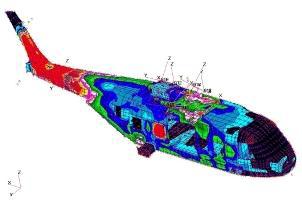On 13 December, Adam Sowa, EDA deputy chief executive, signed the ASTYANAX contract (aircraft fuselage crack monitoring system and prognosis through on-board expert sensor network). Italy, Poland and Spain contribute to this three-year, 4.17 M€ project. The contract was awarded to an industry consortium led by Politecnico di Milano. The research project will focus on the development of a reliable methodology for the application of a Structural Health Monitoring (SHM) system on an aerodyne (rotor and fixed-wing platforms) structure.
ASTYANAX represents an important follow-on of the HECTOR project from the ICET programme (Innovative Concept and Emerging Technologies), which concluded at the end of 2011 with very interesting and useful results. HECTOR developed a preliminary SHM methodology for metallic helicopter structures.
The current ASTYANAX project involves the following partners:
-
From Italy: POLIMI (Politecnico di Milano, consortium leader), ALENIA Aermacchi, AgustaWestland.
-
From Poland: AFIT (Air Force Institute of Technology), MAW1 (Military Aviation Works No. 1) , AGH (University of Science and Technology).
-
From Spain: INTA (Instituto Nacional de Técnica Aeroespacial).
Next steps
The first step proposed in ASTYANAX is to apply the developed methodology and the experience acquired in HECTOR to a large scale helicopter platform .. The results from HECTOR have so far only be tested and demonstrated on simple test beds.
The main objective is to examine the possibility, and assess the requirements, to extend the HECTOR methodology to an air-vehicle fuselage, considering a rotary wing system (Mi-8/17 helicopter) as air-vehicle type. Given the input extension for SHM application on air-vehicle environments, the next step will be to directly apply a validated SHM device to a real platform: the helicopter Mi-8/17 Hip. This platform has been already identified by Poland (and shared by other partners) as suitable system for ASTYANAX’s scope. Inside this platform the aim is to concentrate the attention on a real component, critical for maintenance procedures and, at the same time, available for device testing and development without interfering with safety parameters.
After a preliminary analysis to identify the most suitable component/part, the attention will be focused on a particular structural section defined according to the criticalities identified through the end-user experience in damage occurrences. Moreover, the use of non-electrical sensors will be analysed in details representing an additional clear step further of HECTOR.
The effective output of the research will be:
-
an increase in knowledge needed to pass from a simple methodology (HECTOR) to solve the problems linked to a real application;
-
a deep analysis of different types of sensor useful for the SHM application, with particular attention on Fiber Bragg optical sensors and non-electrical devices;
-
a general development of a structural assessment of a helicopter fuselage through the use of Finite Elements models combined with damage characterization;
-
a creation of a reliable database regarding the damage types and location occurred in the helicopter fleet during the past activities and registered during the maintenance operations.
These outputs will permit to design a device, including both the hardware and the software, obtained through coupling the usage of Finite Elements Modelling for basic knowledge generation with advanced algorithms for structural diagnosis and prognosis. The purpose of ASTYANAX is to acquire an elevated Technology Readiness Level (TRL) for SHM systems (up to 5-6).


ASTYANAX: from model to reality